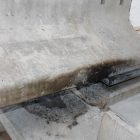NDT methods can be used in routine inspection projects; they can be used to follow up the state of damages in periodical checks. The other advantage of NDT methods is that they can be performed by minimum intervention to the structure. This helps prevent aggravating the problems in already damaged structure. NDT methods can be used to assess the condition of elements that do not have easy access. One example is the deep foundations or mass concrete structures.
1- Ultrasonic Pulse Velocity
 It is traditionally approved that there is a direct correlation between the acoustic wave velocity and mechanical properties of concrete when the acoustic waves propagate through a given trajectory in a medium. On other hand, this is proven that the mechanical properties of concrete decline gradually by damage mechanism development. In case of huge and mass concrete elements, the concept behind this method is applied to assess the quality of concrete when is implemented into the seismic tomography.
It is traditionally approved that there is a direct correlation between the acoustic wave velocity and mechanical properties of concrete when the acoustic waves propagate through a given trajectory in a medium. On other hand, this is proven that the mechanical properties of concrete decline gradually by damage mechanism development. In case of huge and mass concrete elements, the concept behind this method is applied to assess the quality of concrete when is implemented into the seismic tomography.
Learn more Ultrasonic Testing of Concrete
2- Seismic Tomography

This is a developed form of UPV testing in the mass concrete structures. This method consists of the multi-cross-sectional UPV along given trajectories in order to provide 2-D or 3-D velocity contour maps from internal condition of the mass concrete structures. These velocity values can be correlated to the quality of concrete.
3- Impact-Echo

This method can provide a wide knowledge about the position of internal abnormalities such as cavity, honeycombs, delaminated areas, internal cracks. Indeed, a part of emitted acoustic waves by the hammer on the surface is reflected in the boundary of area with different stiffness compared to the main media. Delaminated areas, internal cracks, etc. include smoother areas when compared to the base area. This method is also used to find out about the boundary conditions in the multi-layer media.
4- GPR
The concept behind this technology is that of radar technology in different range of frequencies. This method provides 2-D and 3-D images from the internal parts, embedded objects and their distribution. This can be used to localize the boundary of a multilayer system, delamination, steel rebar, cavities, embedded tubes and cables, etc.
5- Electrical Resistivity of Concrete
The electrical resistivity of concrete can be described as the ability of the concrete to withstand the transfer of ions when subjected to an electrical field. In other words, resistivity is the inverse of conductivity, which can be attributed to the degree of ionic movement in the pores. In this context, resistivity measurement can be used to assess the pore size and extent of the inter-connectivity of pores. These parameters can be directly correlated to the concrete quality, water content of concrete, water absorption, and durability properties of concrete.






Why We Need Structural Health Monitoring? | FPrimeC Solutions
[…] become more important than ever. Modern Structural Health Monitoring (SHM) and innovative Nondestructive Testing (NDT) solutions have been developed in response to such a […]
What is Ground Penetrating Radar | FPrimeC Solutions
[…] of nondestructive testing (NDT) methods are growing in condition assessment of civil structures. NDT methods are commonly used to […]
Steele Honda
Thanks for detailing some non-destructive testing methods for structural evaluation. I appreciate that you mentioned that one of the benefits of NDT is that it can be performed by minimum intervention to the structure. I think that it would be smart to hire a company to do the testing for you so that you could know that it really was going to be non-destructive since they would know what they were doing.